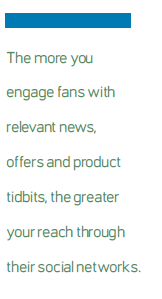The Three M's of Social Commerce

When Mark Zuckerburg coined the term "social graph" to refer to the network of relationships among Facebook users, the contest began for companies to capitalize on how we influence each other's buying decisions.
Emerging and established brands scrambled, and group-purchasing and product-recommendation sites cropped up by the hundreds hoping for a piece of the social commerce pie. More than 50,000 Facebook stores have popped up in the social commerce space, and their evolution is shaping the future of online commerce.
It is the business model of social commerce that is still a moving target. While established channels like the Web, print catalogs and brick-and-mortar stores struggle to formulate their social strategies, innovative companies are turning customers into evangelists with rewards programs, targeted coupons and referral incentives.
Creating a comprehensive social plan may seem challenging, but following a few key recommendations can lead the way for an effective, unique and sustainable commerce experience in the social graph. The following tips will help enterprise brands and retailers leverage social commerce for what it is - a direct link to highly targeted merchandising, effective and highly viral marketing, and influencer metrics that can benefit you and your customers.
Therefore, building an integrated social-commerce experience using the three pillars - merchandising, marketing and metrics - is key to leveraging the power of social networks.
 Merchandising
Merchandising
Engage fans and customers on their terms and their turf
Engage your customers where they spend their time - and with more than 800 million people spending 30 percent of their time on Facebook, it's a good bet. If your storefront appears on their Facebook page and is recommended by a few friends, you have leapfrogged into "trusted resource" status. Creating in-stream purchasing within Facebook allows potential customers to follow a simple checkout procedure that is convenient and seamless. Facebook application authentication paired with return-user data can make purchasing efficient and provide insight into your customer's sharing activity and preferences. Visibility in the newsfeed puts you directly in front of targeted consumers, where they can shop and immediately share purchase information.
Curate with custom store collections
Do you have a celebrity collection or limitedquantity item? Develop a word-of-mouth viral campaign or launch an exclusive promotion targeted at your best customers. Wrapping promotions and rewards around specific product groupings, and building out multiple stores from one system allows you to target specific customer groups across multiple Facebook fan pages.  Activate social networks with new retail models and viral promotions
Activate social networks with new retail models and viral promotions
Sync your Facebook storefront with your existing ecommerce site to launch flash and group-based promotions simultaneously. These limited-time offers, daily deals or sneak peeks can motivate customers to share details with their networks, which results in more traffic to your social storefronts. Help customers spread the word with targeted Facebook and Twitter posts.
 Marketing
Marketing
Enable customers to share everything
When customers share product links, promotions and rewards, reach and effectiveness move beyond traditional advertising and direct marketing, and the cost-per-lead drops. Your customers can quickly and easily pass coupons or friend deals through short URLs that are integrated to other actions on your platform.
Feed your fans with an active news feed
According to EdgeRank, the more you engage fans with relevant news, offers and product tidbits, the greater your reach through your fans' networks. The more relevant and consistent your stream of activity, the more your customers will want to follow you. And if they really like you, they'll share products they like and deals that are too good to pass up. Build and keep actions inside your Facebook storefront, creating a tightly woven web that supports your social and commerce structure.
Encourage customers to rate, review and share opinions
Research shows that 95 percent of consumers are more likely to try products recommended by friends. Incentive programs can encourage customers to share their purchases and write reviews about their favorite products. This is an easy way to introduce a credible influence on purchase consideration earlier in the funnel.
Allow curation with social wish lists
Allowing customers to create wish lists that are personalized and shareable gives you specific insight into their products and purchasing decisions. With that information, you can create product collections and promotions tailored just for them, which they can share across their social networks.
 Metrics
Metrics
Measure and identify social commerce influencers
Your best customers are your biggest evangelists, not necessarily your biggest spenders. Measuring the impact of social activity on actual revenue by analyzing the effects of shared links, coupons, referrals and rewards allows you to identify, encourage and reward your top customers.
Reward Brand Evangelists
Reward your brand evangelists with status-based campaigns or sharable coupons and points. These programs can be simple or sophisticated depending on your products, operation and level of customer engagement. Successful programs can increase cart and transaction volume across your enterprise.
Shareable coupons make buying contagious
Create social coupons based on product, group, category or brand, and trace their distribution through trackable URLs. You can use social coupons to reward customers for sharing reviews or products and promotions, measure their effectiveness and modify programs to promote more evangelical behavior.
Create VIP status to qualify and reward your best customers
Validate your top influencers with rewards their friends will also want to achieve. You can rank high achievers on social-sharing activity, offer badges based on store actions and referral programs, and stratify customers according to merit. When you offer opportunities, incentives and status for sharing valuable rewards, more members from your customers' social networks will come to you looking to obtain that kind of VIP status.
Maximizing the Three Ms
It can be unsettling to relinquish some control over your brand and marketing to the unpredictable impulses of your customers' social networks. Navigating the Web of social commerce means maximizing your chances for spreading good conversations and giving customers incentives and opportunities to turn those conversations into transactions. This is best done through incorporating the 3Ms into your social commerce program.
1. Merchandise in the social channels where people spend their time.
2. Fuel social conversation with engaging, viral promotions and exclusive, curated products, and feed consumers with opportunities to shop and share with friends.
3. Measure, segment and reward your customers who have the highest commerce influence score.
As social influences increasingly impact online commerce, integrating yourself into the conversations your customers are having is critical to your success. Building your social-commerce strategy around merchandising, marketing and metrics can prepare your company to effectively capitalize on the rapidly evolving social channel.
About the author: Matt Compton is the CEO of ShopIgniter, a social commerce software company that helps leading brands and retailers activate their social networks to extend their reach and generate revenues.

Subscribe to Our Newsletter!
Latest in Social Media










